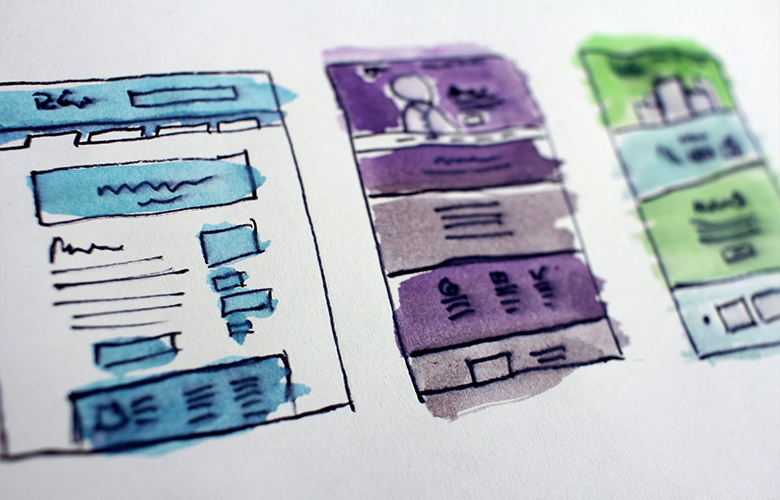
A few years ago, I attended a user experience design boot camp. That course taught me that UX is so much more than designing visuals for apps and websites. UX designers conduct a lot of user research to determine how an app should function, implementing what they call a “human-centered approach” to their decision making; that is, an approach that ensures the final product serves the user.
Since then, I have been meaning to write about the similarities between sound designers and user experience (UX) designers. Sound designers use design thinking strategies all of the time! Through careful analysis and experimentation, we consider the end-user product. For us, that’s usually a film, play, video game, podcast, concert, etc. Even though the tools are very different, the process is very similar. This article will examine the crossover between design thinking and the sound design process through the five phases of design thinking.
The first thing user experience designers do is evaluate and research user needs through a “discovery phase.” They will conduct interviews with users surrounding their specific needs and desires around a product. They may also send out surveys or observe users’ nonverbal interactions. What they are looking for is a problem to solve. This first stage is really systematic because although researchers have a specific topic to evaluate, they do not go into the discovery phase with a pre-determined issue. They find it through interacting with users. This makes for an unbiased approach because the research is being conducted objectively and no one is making assumptions about end users’ desires and needs. This academic approach allows for discovering users’ needs so that the end product will actually serve them.
If phase one for the UX designer is about gaining an understanding of the user, phase one for the sound designer is about gaining an understanding of the message, environment, and characters within an experience. The sound designer’s discovery phase involves reading the script and talking to the director about their intentions with the story’s message. They may also begin to look at the work the visual team has done to begin to gain an understanding of the environment. Before talking to the team, the sound designer should have already read the script and begun to think about the message. However, they haven’t made any sure-fire decisions about how the experience should sound until after talking to the director and the team. Even if they have ideas, the sound designer keeps an open mind and conducts objective research.
In this sound design/UX design analogy, the director is the user, at least in this first phase. Much like UX designers, the sound designer first asks non-leading questions to understand what the experience needs; goes in with an unbiased approach, and is ready to pivot if their initial interpretations of the script are not in line with the director’s vision.
The user experience designer has a bunch of quantitative and qualitative data from user interviews and tests — now what? The next step is laying out all of the information in a way where the data can be synthesized into findings. This is usually a very hands-on approach. A common technique UX designers will use is called affinity mapping. Every answer or observation is written on a post-it note, then “like” things are grouped together. The groups with the most post-its will inform the UX team about users’ most common and important needs and expectations. Then, they will begin to write up a problem statement, which is usually phrased as a question: “How might we [accomplish X thing that users need]?” Keeping it focused on the issue at hand keeps the approach unbiased and user-centered. The problem statement is a goal, not a sentence that is proposing a solution. The problem has not been solved yet; it has just been defined.
In the same way, UX designers define the problem statement, a sound designer’s second phase involves defining the message; the overall feelings and thoughts that the audience should take away from the experience. They may combine notes from their initial script reading and the conversations they have had. They may also go through the script for sound effects that are mentioned if they did not do that during the first read-through. This is where they define the world and mood of the experience. Some sound designers might even write down their own version of a problem statement, which is the goal or message of the experience. Sometimes in my work, I have found that it is helpful to have a goal for an experience written down so I can keep referring to it and checking that my work is in line with the tone of the piece.
In both roles, keeping a main goal or statement keeps the process about the end-user or audience. While a designer in either role might end up lending their own artists’ voice to a project, maintaining an unbiased approach (starting with a problem statement or message) keeps everything that is designed about the characters and the story.
After user experience designers spend all this time cultivating data, they get to start brainstorming features! A human-centered approach is very systematic; to create a meaningful and relevant product, designers can not get here without the first two phases. Every proposition for a feature is based on user research.
Similarly, the sound designer has defined the director’s expectations and the message, mood, and physical environment in the first two phases. The ideation phase is usually about watching and listening to reference material and beginning to gather and record audio. Much like user experience designers may not implement all of the features they think of, a sound designer might gather sounds that they do not end up using at all.
For both roles, this is when people are referring to their research and brainstorming ideas just to see what sticks. During the third phase, user experience designers are constantly referring to the research and problem statement, and sound designers are referring to their script and notes.
This is where things begin to heat up! All that data starts to become a real, tangible experience. At this point, the user experience designer has developed a few prototypes. They can exist as paper prototypes or digital mock-ups. They may have a couple of versions in order to conduct usability tests and see what is most relevant and meaningful to users. Designers will build prototypes, test them, get feedback, build a new version and test again. A cycle exists between these phases, and whatever is discovered in phase five will influence a new phase four prototype, then it is on to phase five again for more feedback…Rinse and repeat until the design is cohesive (or the project runs out of time or money). Testing and getting feedback is very important, to make sure the work continues to serve the users or audience.
A sound designer’s prototype is often the first pass at a full design. For theater, it can be cues they send to be played in rehearsals; for other mediums, it is about inserting all the audio elements and taking notes from the director. Then, they implement different effects for a few iterations until they reach approval from the director and producers. In the sound designer’s case, the director is akin to a beta tester in UX research.
During testing, user experience designers and sound designers have similar considerations to evaluate:
Design thinking strategies are far from linear. Throughout the process, a user experience designer or sound designer refers to their initial research and notes to keep their decisions focused on the audience. They will prototype features (UX) or effects (sound), test them out, take feedback, redo, and test again.
A great sound design, while influenced by that artists’ voice, is unbiased and serves the story. A solid product design does the same thing; because at the end of the day, a user’s journey with a product is a story. Consciously implementing design thinking strategies also makes our approach as sound designers human-centered, resulting in stories that have a huge impact on the audience. A solid, well-researched and thought-through design can bring a project to another level completely; by touching our audiences and end-users in deeply emotional ways, we provide a meaningful and relevant experience to their lives.
The Basics of Sound: What Is It and How Does It Work?
Female Sound Engineer in Bollywood: Giving Up Was Not A Choice


The mission of SoundGirls.org is to inspire and empower the next generation of women in audio. Our mission is to create a supportive community for women in audio and music production, providing the tools, knowledge, and support to further their careers. SoundGirls.Org was formed in 2013 by veteran live sound engineers Karrie Keyes and Michelle Sabolchick Pettinato and operates under the Fiscal Sponsorship of The California Women’s Music Festival, a 501(c)3 non-profit organization. In 2012, Karrie and Michelle participated in the “Women of Professional Concert Sound” panel at the AES Conference in San Francisco. The panel was hosted by the Women’s Audio Mission (WAM) and moderated by WAM founder Terri Winston. Terri brought together five women working in live and broadcast audio. The groundbreaking panel (which also included Jeri Palumbo, Claudia Engelhart and Deanne Franklin), provided young women and men a glimpse into life on the road, tips and advice, and a Q & A with the panelists. More importantly though, was how incredibly powerful the experience was for the panelists. We had all been in the business for 20 years or more, yet most of us had never met before that day and within minutes we bonded like long-lost sisters. We were struck by how similar our experiences, work ethics, and passions were and wondered why our paths had never crossed and how our careers would have been different had we been there to support each other through the years. Each of us are strong on our own, but together we were even stronger and a powerful force. We were empowered. Each of us had been asked hundreds of times in our careers: Are there other women doing sound? How did you get into sound? How would a young woman go about getting into sound? Through creating SoundGirls.Org, we hope to establish a place for women working in professional audio to come for support and advice, to share our success and failures, our joys and frustrations, and for empowerment and inspiration.
Read Full Profile© 2021 TheatreArtLife. All rights reserved.

Thank you so much for reading, but you have now reached your free article limit for this month.
Our contributors are currently writing more articles for you to enjoy.
To keep reading, all you have to do is become a subscriber and then you can read unlimited articles anytime.
Your investment will help us continue to ignite connections across the globe in live entertainment and build this community for industry professionals.